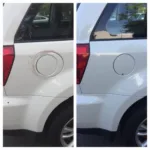Rust is the enemy of any car. Left unchecked, it can spread like wildfire, compromising the structural integrity of your vehicle. Car rust repair paint is your first line of defense against this insidious foe. This guide will explore everything you need to know about dealing with rust and restoring your car’s finish.
Car paint and rust repair isn’t just about aesthetics; it’s about preserving the value and longevity of your vehicle. From minor surface rust to more significant corrosion, understanding the right approach to car rust repair paint is essential. We’ll cover everything from identifying rust in its early stages to choosing the right products and techniques for a professional-looking finish.
Identifying and Assessing Rust Damage
Before you begin any car rust repair paint project, it’s crucial to accurately assess the extent of the damage. Surface rust appears as small, discolored spots on the paint. If caught early, this can often be treated with a rust converter and touch-up paint. More advanced rust, however, may require sanding, priming, and even body filler. Rust bubbles on car paint are a telltale sign of serious underlying corrosion.
What causes rust in the first place? The primary culprit is the exposure of bare metal to moisture and oxygen. Chips in the paint, scratches, and even minor dents can create pathways for these elements to reach the metal, initiating the oxidation process that leads to rust.
Choosing the Right Car Rust Repair Paint and Materials
Selecting the correct car rust repair paint is crucial for a successful and long-lasting repair. For minor rust spots, a rust converter can be used to chemically transform the rust into a stable compound that can be painted over. For larger areas, you’ll need to remove the rust completely using sandpaper, a wire brush, or a sanding disc. Priming the bare metal is essential before applying the car rust repair paint. This helps to prevent further rust and ensures proper adhesion of the paint.
Car stone chip rust repair paint is specifically designed for small, localized areas of rust, often caused by stone chips. It typically comes in a small applicator for precise application. Don’t forget the necessary safety equipment like gloves, eye protection, and a respirator when working with car rust repair paint products.
The Car Rust Repair Paint Process
Repairing rust and repainting your car can be a DIY project, but it requires patience and attention to detail. First, clean the area thoroughly with soap and water, then dry it completely. Apply the rust converter, if using, and allow it to dry according to the manufacturer’s instructions. Next, sand the affected area to remove any loose rust and create a smooth surface for the primer. Apply the primer evenly, allowing it to dry completely before applying the car rust repair paint.
Car body rust repair and paint can be a more involved process, particularly if significant bodywork is required. For deeper rust penetration, you may need to use body filler to restore the shape of the panel before priming and painting.
“When dealing with car rust, preparation is key,” says renowned automotive restoration expert, James Miller. “The more time you spend properly preparing the surface, the better and more long-lasting the results will be.”
Preventing Future Rust
Preventing rust is always better than treating it. Regularly washing and waxing your car can help protect the paint and prevent chips and scratches. Touch up any paint chips promptly using car paint and rust repair products. Keeping your car garaged can also minimize exposure to the elements. Inspecting your car regularly for signs of rust, particularly in areas prone to moisture accumulation, can help you catch and address rust issues early.
“Regular maintenance is the best defense against rust,” advises automotive specialist, Sarah Chen. “A little preventative care can save you a lot of time and money in the long run.”
Conclusion
Car rust repair paint is an essential tool in maintaining the appearance and longevity of your vehicle. By understanding the causes of rust, the different types of car rust repair paint products available, and the proper repair process, you can effectively combat rust and keep your car looking its best. Don’t let rust win; take proactive steps to protect your investment. Remember, early detection and treatment are key. Learning how to repair rust bubbles on car paint is crucial for preventing further damage. Knowing the matreial needed repair rust paint damage to car will allow you to get started right away.
FAQ
- What is the best car rust repair paint? The best car rust repair paint depends on the severity of the rust. For minor surface rust, a rust converter and touch-up paint may suffice. For more severe rust, a dedicated rust-inhibiting primer and automotive paint are necessary.
- Can I repair rust on my car myself? Yes, minor rust repair is a manageable DIY project. However, extensive rust damage may require professional intervention.
- How do I prevent car rust? Regularly washing and waxing your car, addressing paint chips promptly, and storing your car in a garage can help prevent rust.
- How long does car rust repair paint last? With proper preparation and application, car rust repair paint can last for several years.
- What is a rust converter? A rust converter is a chemical product that transforms rust into a stable compound that can be painted over.
- Can I paint over rust? You should not paint directly over rust. The rust needs to be treated or removed before painting.
- What causes rust on cars? Rust is caused by the oxidation of metal when exposed to moisture and oxygen.
Need assistance? Contact us via WhatsApp: +1(641)206-8880 or Email: [email protected]. Our customer service team is available 24/7.


